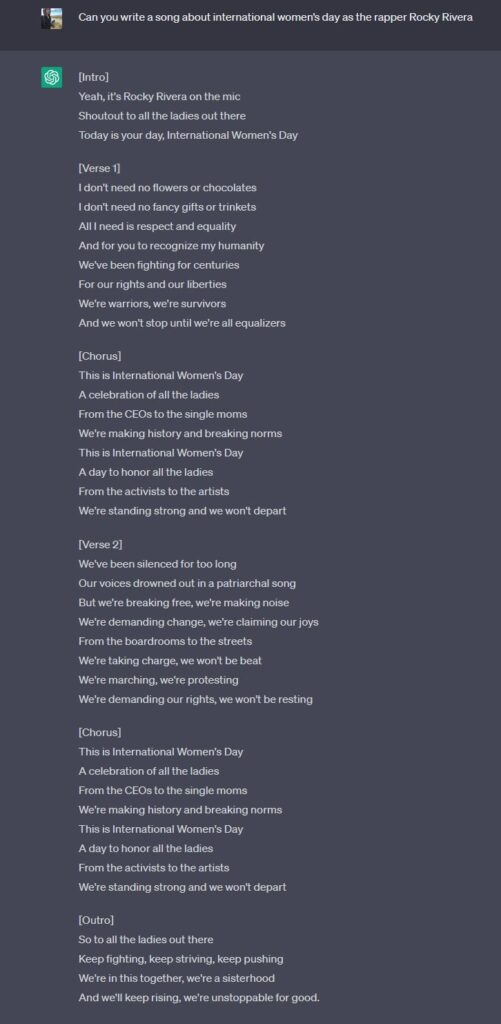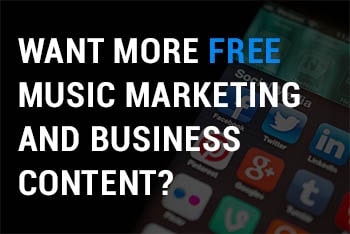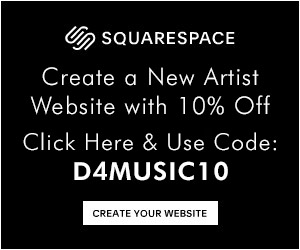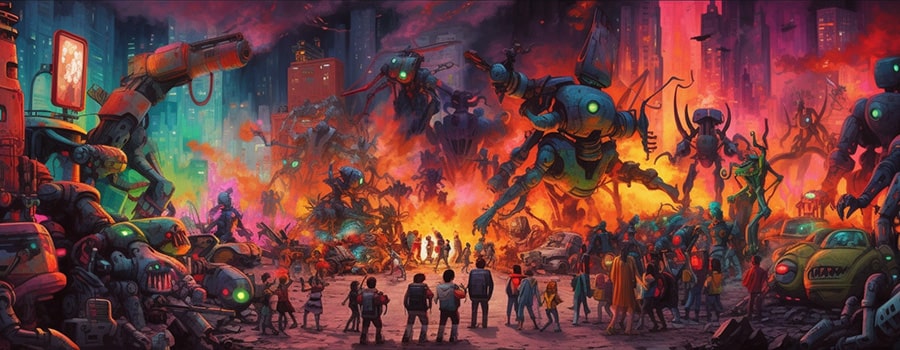
Parts of the blog were written with the assistance of ChatGPT. All images used in the blog, including the header, were generated using MidJourney.
Not too long ago, Non-Fungible Tokens (NFTs) were all the rage in 2021. But more recently, AI has been the buzzword coming into 2023. Aspects of AI, like the infamous social media algorithms, have been the musician’s archenemy over the past several years with sharp declines in organic reach, but will AI become the final boss or the hero to save the day?
With the rise of artificial intelligence, AI stories have been taking over more and more headlines, newsfeeds and conversations. There’s no way that the mention of AI and all of the headlines it has made hasn’t come across you on social media or within your social network.
The big question is what does this mean for artists, creatives and musicians? Is AI’s rise a blessing or a curse? Can AI replicate human creativity? Who owns the copyright to what AI produces?
In this blog, I explore the good and the bad (mostly good) with AI as it relates to independent musicians. If you’re new to AI, this beginner’s guide is a great place to start. I also share 25+ AI tools you should consider trying. Because many of these AI tools are free to use or have a free plan, I highly encourage you to give them a shot and start experimenting with the technology.
First, The Bad Side of AI
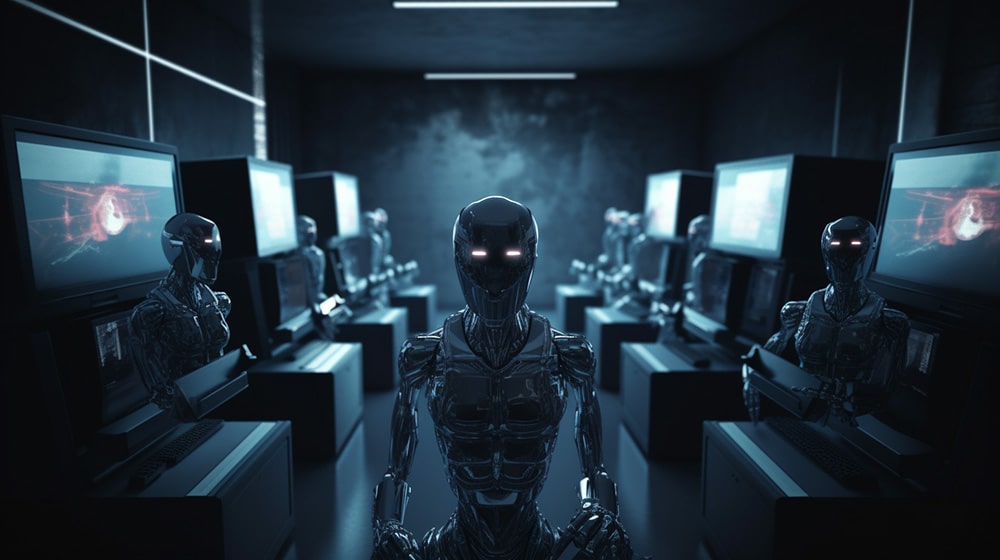
While AI’s capabilities are undoubtedly fascinating (and sometimes amusing), it seems like most of the focus has been on its downsides.
You have thousands of deepfake songs made and uploaded using AI to recreate voices of popular artists without their permission. These AI-creators are using their likeness without permission or compensation. “Heart On My Sleeve” using the voices of Drake and The Weeknd actually went viral before a takedown was issued on digital platforms by their labels.
It was accidentally discovered that Google Assistant’s song recognition feature was able to identify samples in songs less than a second long, even if it was manipulated. This has created a lot of concern for many Hip-Hop producers who use samples in their music since it allows just about anyone to identify these unlicensed recordings in a song. It’s already bad enough for them that you have sites like WhoSampled. On the flip side, this could be viewed as good thing because it allows artists easy access to a tool that can detect unauthorized use of their IP.
In addition to some of the bigger concerns with AI like copyright infringement, questions of AI-output ownership and violations of rights to publicity to high profile individuals, you have many fears of job displacement. Could graphic designers and writers be replaced with these advancements in AI? What about musicians?
All these examples of what we see with AI today is only a taste of its potential. You know that AI will only get better in time because it’s in its nature. Depending on how you look at it, this could be really exciting or terrifying.
Personally, I try not to focus on the negative side of things, especially when I don’t have control over a rapidly growing technology like artificial intelligence. There will be people who have moral or ethnical issues with AI, and that’s totally understandable. It’s no different than with what we saw in the rise of digital distribution of music (MP3 downloads and music streaming) that replaced the need for physical music formats and decimated a highly profitable income stream for musicians until this day.
So instead, I prefer to focus on understanding how this increased accessibility of AI technology can benefit independent artists now.
What is AI (Artificial Intelligence)?

Even though it seems like it came out of nowhere, AI has been developing for decades and it’s very likely your life has been directly influenced by it or helped in some way. What changed was the introduction of two popular AI tools, both made by the same company OpenAI, that were made publicly available to use.
DALL-E 2, a popular AI text-to-image generator, was made available for people to try out in the summer of 2022. Then in late November, ChatGPT launched and created a frenzy. In the first 5 days of its release, the AI tool reached 1 million users. By January of 2023, it set the record for the fastest-growing platform with over 100 million users.
Before moving further, it’s only appropriate to explain how we got to this point and define what artificial intelligence (AI) is, in case you’re not entirely sure what it is.
What better way to explain artificial intelligence than to let one of the most popular AI tools at the moment ChatGPT explain it. I asked it to explain what AI is, how it relates to algorithms and machine learning and provide some examples of how we’ve been influenced by AI already without realizing it.
Here is the response:
Artificial Intelligence (AI) is a field of computer science that involves developing algorithms and computer programs that can perform tasks that typically require human intelligence. This can include understanding natural language, recognizing patterns, and making decisions based on data.
One subfield of AI is machine learning, which involves creating algorithms that can learn from data without being explicitly programmed. This approach allows machines to automatically improve their performance over time based on the data they are given.
Algorithms are a set of instructions or rules that are followed in order to complete a task or solve a problem. In the context of AI and machine learning, algorithms are used to process data, make predictions, and improve the performance of AI systems.
Here are some examples AI has already influenced daily life for the past few years now:
- Personalized recommendations on streaming platforms like Netflix and Spotify, which use AI algorithms to suggest content based on your viewing and listening history.
- Voice assistants like Siri and Alexa, which use natural language processing to understand and respond to spoken commands.
- Social media platforms like Facebook, which use AI algorithms to suggest posts, filter out spam, and identify potentially harmful content.
- Online shopping sites like Amazon, which use AI algorithms to suggest products based on your browsing and purchase history.
- Navigation apps like Google Maps, which use AI algorithms to suggest the fastest route based on real-time traffic data.
For independent artists, the keywords in the definition that should stand out are “perform tasks that typically require human intelligence.”
The Role AI Can Play In Your Music Career
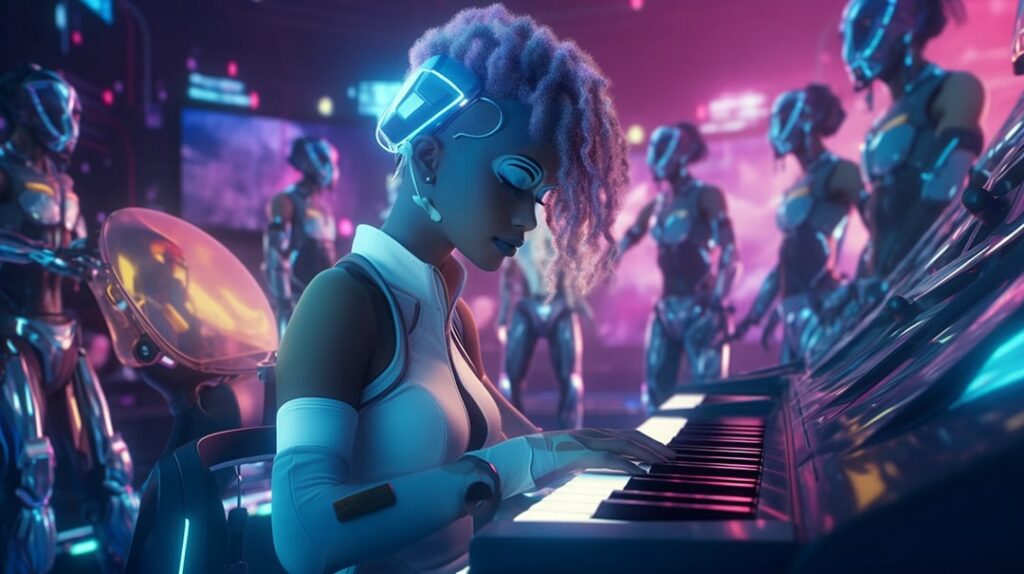
While there are concerns that AI may replace artists and musicians, I personally don’t see that happening. Technology will always disrupt industries and affect certain income streams but it often opens up other opportunities in the process.
A report by TuneCore found that 50% of the independent artists who were surveyed are aware of AI and have a positive perception of its benefits and opportunities. 27% of them have already started using AI music tools to do things like help in the creative process, create artwork and make promo assets.
On the other hand, 39% of the artists in this report were unaware and apathetic towards AI, expressing fears and concerns with the technology. Because we’re still early in the adoption phase, its expected the sentiment around AI to be split.
AI may be able to replicate your likeness, but it can never replace your brand and the humanistic characteristics that fans connect with. This is why I emphasize the importance of branding (and even wrote a free e-Book about it). Having a strong brand is essential regardless of AI advancements, as music’s true essence lies in emotional human connections with the artists.
As musicians, adaptation is the key to navigating these changes. If you can’t control it, you find ways to work with it to your advantage.
With the power of AI more accessible to you now, it can help you:
- Save time
- Save money
- Increase productivity
- Be more efficient
- Spark more creativity
For independent artists struggling with limited resources, AI can serve as a cost-effective assistant on their team. For example, if you’re an emerging artist working solo, you can save money using these various AI tools instead of hiring someone who can be costly. The output will likely not be perfect and usable on the first try, but over time it will only get better.
Here are some of the areas AI will be able to help in:
- Business-Related Writing (Bio, Email, Press Release)
- Music Production
- Songwriting
- Mixing & Mastering
- Graphics / Images (Album Art, Merch Ideas, Logo)
- Video Content & Editing
Important AI Concepts To Know
For many, the world of AI is still brand new. Here are 3 key concepts you’ll need to know about when working with AI:
1. Prompts
If you want to get the most out of AI, you need to know how to write good prompts. A prompt is simply the text instructions and/or description of what you want an AI tool to produce. Think of it as typing something into a search engine except you can get much more detailed. It’s really a skill within itself where you can get better with practice and learning how a particular tool responds to different wording/phrasing.
Not all AI-tools will respond the same to the phrasing you use for your prompts so you may want to look up guides for individual tools or watch tutorial videos to see how you can maximize your results. Good output depends on good input so understanding how to write good prompts is key with using AI to its potential.
If you are writing a prompt for a text-to-image generator, start with a general prompt to get a feel of what you get at first then get more descriptive. Some platforms will allow you to see what prompts others used to get their results so you can copy some of their phrasing.
For text generation like ChatGPT, write detailed prompts as if you’re asking another human to do it. This means you can write multiple sentences to provide context and be specific with your needs. You can also ask AI to rewrite in a specific tone, style and reading level. You can even suggest a target audience or “act as” a certain type of person.
2. AI Training
In order for AI to generate desired outputs, they need to be trained. AI training is teaching a computer system to recognize patterns and make decisions based on a large amount of data.
As a user of these AI tools, you need to be aware of the contents and data that the AI system has been trained on.
For example, the version of ChatGPT that is currently available for people to use for free was trained on data before 2022. This means that if you reference anything that took place in 2023, it won’t be able to help and will provide inaccurate information.
Knowing what data an AI tool was trained on will help you generate better output that is relevant to your needs. It’s very possible in the future, there will be AI that will be trained on data specific to music and art to provide even more accurate results for musicians.
Now let’s look at images. If an AI image generator is trained on all the photos found in Google Images, then there’s a strong likelihood that it will pull from copyrighted works to produce the output. This is particularly true if your prompt is asking to generate something in the style of a famous visual artist. Is this copyright infringement? That’s what is discussed next.
3. Copyright
There’s still a lot of uncertainty when it comes to AI and copyright as the laws are not up-to-date to handle these issues.
As of now, AI-generated content is viewed as completely original works so most of the AI tools available now should grant you rights to use and are safe to use commercially. But you are not allowed to register AI-generated works for copyright as of this writing. Before you use any AI-generated works from these tools, it wouldn’t hurt to read up on their terms and conditions to confirm.
However, there’s still a lot of gray area when dealing with the contents used to train the AI. If AI is pulling its data from copyrighted photos, images or artworks to generate an output, it would make sense that this would be considered infringement similarly to sampling is in recorded music. Then it begs the question of attribution and who is responsible? Is it the user or the AI company and their programmers?
This is why you should be aware of what data the AI was trained on. You don’t want to use AI to generate something like an album cover or merch design, only later to find out it was in violation of copyright laws. To be safe, avoid using the likeness of any specific individual if you’re going to use for your business.
1. Business-Related Writing
There’s a lot you can have AI help you with in terms of business-related writing as a musician. Here are some things an AI text generator can help you write:
- Artist bio
- Press releases
- Pitching emails
- Social media captions
- Ad copy
Not only that, you can have AI summarize text (long bio into a shorter version) or generate multiple variations (email subject lines) to get ideas. If you’re unsure about how to phrase a prompt to get what you want, just ask!
Just be aware that these AI writing tools aren’t perfect so you’ll likely have to refine the results and even make some tweaks and edits. Don’t expect to just know your life story and be able to craft the perfect bio on the first try. You can also provide bullet points or sentences for it to pull from and generate what you need. It can help save time by providing a foundation to start with.
Here’s an example of a bio I had generated of someone I work with. This is without providing any information and seeing what data the AI was going to pull.
As expected, a majority of the facts were incorrect but at least the data it was trained on knew her label and album title names.
Here are some tools you’ll want to mess around with:
Bard by Google: This is Google’s competitor to ChatGPT but completely free.
Jasper: Considered as one of the top AI writing tools, but unfortunately there are no free plans. The cheapest plan starts at $39/month and offers a free 7 day trial.
HyperWrite: Offers a free plan but you’re limited to how many text generations, rewrites and suggestions as you type a month. The paid plan starts at $19.99/month.
HuggingFace: An open-source ChatGPT alternative. As of this writing, it doesn’t look like there are any paid plans so everything should be free with no restrictions. I will note that it was definitely not good with writing bios.
2. Music Production
Whether you need to be more efficient with your production or help generating song ideas, there are a few AI tools for you to choose from.
We’re not quite there yet with text-to-music generation like we are with images, but it looks like it’s on its way with tools like Google’s MusicLM. Even Meta is developing their own version with AudioCraft.
Whether you have experience producing music or not, here are some AI driven tools to consider trying:
Magenta: A free collection of AI powered music plug-ins made by Google for applying machine-learning in MIDI creations. It can be used as a standalone app or as plugins in Ableton Live.
Orb Producer Suite: A collection of 4 VST3 / AU plug-ins (Melody / Chords / Arpeggios / Bass) to make music using artificial intelligence. It’s downloadable for both PC and Mac with a one-time purchase.
Boomy: This is a very simple browser-based AI music generator that anyone with no music production experience can use. Select a song style and it will generate a random beat for you. From there, you can tweak the settings, add vocals, rearrange the bars and rewrite the composition. You can even distribute and monetize the song on digital platforms directly from their platform. Here’s an example of an instrumental track I made and released through Boomy.
Google’s MusicLM: One of the first big text-to-music AI tools to be made available and free to use. As of this writing, Google is slowly opening it up to the public for testing. However if you want to try it, you have to get on the wait list first.
BandLab’s SongStarter: Free AI music generator to help you come up with song ideas based on song styles or even a lyric. It’s similar to Boomy initially, but you have much more control and advanced options within a DAW interface.
3. Songwriting
The tools you would typically use for songwriting nowadays are the thesaurus and rhyming dictionary. In the future, it will be AI.
However, I wouldn’t exactly use AI to write full songs for you (it’s not quite there yet), but it can be useful to help with ideas and suggestions. When it comes to writing lyrics, AI can help get you started, get over writer’s block or finish that last part giving you trouble.
The first time I actually used ChatGPT was on International Women’s Day. For fun, I decided to see how AI would do writing lyrics as my client, who is a feminist, about this day. Here’s what it came up with.
As you can see, the lyrics are quite elementary but I was initially impressed that it was at least comprehensive.
To get started, you can use some of the AI text generators, like ChatGPT, or one of the following tools that are specific for song writing.
These Lyrics Do Not Exist: Web-based tool that generates full song lyrics based around a song topic, genre and mood. Currently free to use.
Audioir: This developer has an app for lyrics called My Lyrics Maker and an app for AI Music Pro for melody and harmony.
Amadeus Code: This tool is currently only available for iOS. There’s no free plan but they offer a free 14 day trial period. Otherwise, it starts at $1.99 per song.
4. Mixing & Mastering
Mixing and mastering your tracks for your songs can be pricey. Using AI can be a more affordable way to improve the sound quality and dynamic range of your music.
Bandlab Mastering: Free AI mastering tool.
Masterchannel: Web-based with free plan available. Paid plan starts at $15/month paid annually.
eMastered: Offers unlimited masters and unlimited downloads with only one plan that starts at $13/month paid annually.
AudioShake: Upload a song to split the music into its instrument stems using AI.
5. Graphics / Images
Need cover art ideas for your next music release? Want to create new merch but not sure what to use for a design? Or maybe you’re starting out and need a logo. Try using an AI image generator.
Not only can you create images and art from text prompts, some of these tools can also help with image/photo editing that may be more advanced for some like removing objects and backgrounds.
Some of these tools are really impressive and can do realistic looking images simply from your text prompts. It’s mind blowing that you can have some of the most imaginative, random images you can think of generated with these tools. Because each tool is trained with different data, try using the same text prompts in different tools to see how the results differ.
If you don’t have time to experiment and play with prompts, you can actually pay to get the text prompt for specific look. PromptBase is an AI prompt marketplace that specializes in visual prompts for all the popular text-to-image AI tools.
MidJourney: Another very popular AI image that allows you to generate 25 images for free if it’s not too busy. A paid subscription starts at $10/month. Unlike other tools, MidJourney takes place in their Discord server so you will need to sign up for a free Discord account. The advantage of this is that you can see what others are generating through their prompts so you can learn how to get better at describing what you want.
DreamStudio: This is a fairly simple image generator where you describe what you want in detail with text. You start off with free credits to try it out.
Starryai: This tool is more straightforward with only 2 options so it’s good if you’re new to AI. You can use text to generate an image that is more art-like or more photo-realistic. You get 5 free credits a day.
Dream by Wombo: App-based image generator available on both iOS and Android.
Looka: This tool uses AI to help generate logo designs. Generate and customize a logo starting at $20.
AI Image Upscaler: Some of the AI generators above will export the images in a resolution by default that may not fit your needs. If you can’t figure out how to export with higher resolution, another option is to use AI to upscale the image without sacrificing quality. This free tool will allow you to upscale up to 400%. So if you have an image that is 1024 x 1024, you can make it 4096 x 4096 to meet the requirements to upload as cover art for example.
6. Video Content and Editing
We all know how important video content is to promote your music and your brand. With the help of AI, you can make some visually appealing video clips to post on social media with little to no editing experience. These AI videos could even be used for Spotify as a Canvas video.
In early 2024, we’re starting to see text-to-video tool Sora (from Open AI) gaining traction. The examples I’ve been seeing are wild so I highly recommend checking them out. Although not available for the public to use as of this writing, it opens up a lot more potential of how AI can help artists with content creation.
With AI, you can also use it to help you come up with ideas and concepts for a music video. To test this out, I asked ChatGPT for music video concepts based on a set of lyrics about an ex-girlfriend called “My Favorite Ghost.”
Here’s what it came up with:
Personally, I thought it was impressive how it was able to interpret the lyrics to come up with very relevant ideas. You can read the full song lyrics here.
As for actual video related AI tools, here are some to look into:
WZRD: This tool allows you to make visuals that move with your music. Upload a song and choose from sets of AI generated photos you want in the video. It’s free to create 30 second previews but there will be a watermark. If you pay, it costs $14 for a credit. One credit buys you 1 minute of audiovisuals.
Runway ML: This is a really neat web-based creative suite with 30+ AI editing tools for photos, audio and videos. You can do things like remove objects in a video and remove the background to turn into green screen video. You start with credits so you can try their tools for free, but there are certain limitations. The paid plan starts at $12/month.
Conclusion
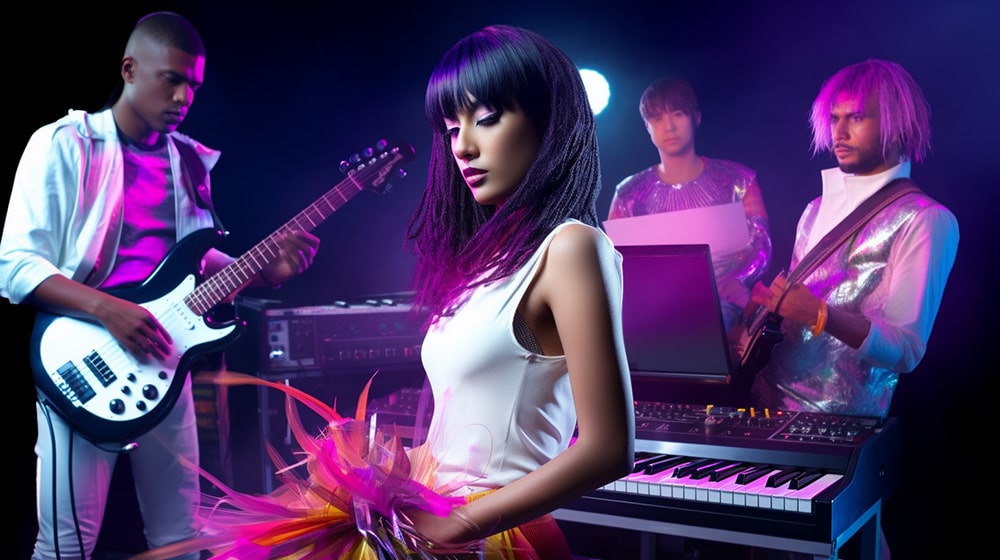
With the current tools and apps available, we can see that AI has great potential in helping independent artists. The crazy thing is we’re just scratching the surface and it’s only going to improve.
With the AI revolution clearly upon us now, it would be a good time for independent artists to get familiar and start experimenting. I will be updating this blog frequently as I continue to experiment with the different tools myself. Just like with NFTs, I don’t see AI going away. You can worry and try to fight it or accept it and find ways that AI can benefit you. The choice is out to you… for now.




